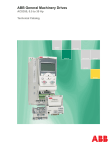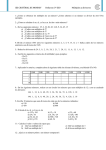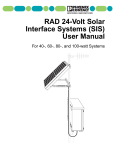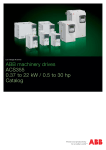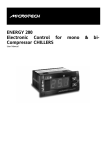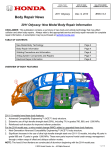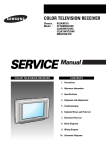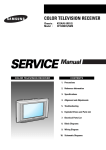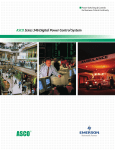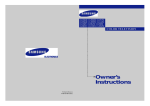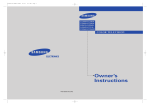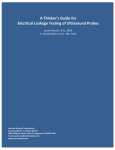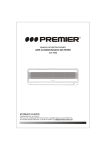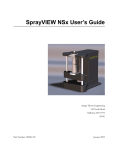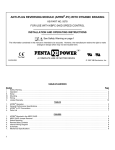Download User`s Manual for Bodine UPM Unfiltered SCR - Innovative-IDM
Transcript
Instructions for Installation and Operation Type UPM Unfiltered SCR Speed Controls for Permanent Magnet DC Brush Motors ■ ■ Model 0865, quick connect tabs for electrical connections Model 0866, plug-in terminal block for electrcial connections SPECIFICATIONS Input Voltage: 115/230 VAC +/- 10%, 50/60 Hz, single phase Max. Input Current: 8.2 Amps RMS at current limit with largest motor Output Voltage (115 VAC Input): 0-90 VDC Output Voltage (230 VAC Input): 0-90 VDC or 0-180 VDC Ambient Temperature: 0-50° C. Max. Output Current, Continuous: 2.1 Amps DC Max. Output Current, Peak: 5.1 Amps DC Speed Regulation: 1% of rated speed obtainable with most motors Acceleration Time: (0-90 VDC) Adjustable, 0.2-10 seconds Acceleration Time (0-180 VDC) Adjustable, 0.2-20 seconds Deceleration Time (90-0 VDC) Adjustable, 0.2-10 seconds Deceleration Time: (180-0 VDC) Adjustable, 0.2-20 seconds Means for Speed Adjustment: 10K ohm potentiometer or isolated 0-5 VDC signal Means for Drive Inhibit: switch closure Diagnostics: green power LED, red current limit LED R INSTALLATION WARNING: This control should only be installed by a qualified person familiar with its operation and associated hazards. The National Electrical Code (NEC), local electrical and safety codes, and when applicable, the Occupational Safety and Health Act (OSHA) should be observed to reduce hazards to personnel and property. Step 1: Mounting the Control CAUTION: Exposed circuit boards should be protected from electrostatic discharge during handling to prevent component damage. CAUTION: Mount the control chassis in an enclosure suitable for the application environment. 1.50 3.64 .50 (TYP.) 2.50 (TYP.) 1.25 .25 (TYP.) 3.80 (TYP.) 4.30 DIP SWITCHES JP1 .09 (REF.) .094 R. SLOTS (6 PLACES) .95 (TYP.) FIGURE 1 – Control mounting dimensions The control may be mounted with the circuit board horizontal or vertical. The mounting slots in the heat sink will accept #8 screws. Step 2: Preliminary Setup INPUT VOLTAGE JUMPER – Fig. 1 shows the location of JP1, a 3-pin header. A jumper is factory-installed for 115 VAC. If operating from 230 VAC, remove the jumper and reinstall it in the “230” position. HORSEPOWER & OUTPUT VOLTAGE SELECTOR SWITCHES – Fig. 1 shows a bank of 8 dip switches. Set switches 1 thru 7 to match the type, voltage, and speed ratings on the Bodine motor nameplate per Fig. 2 (consult Bodine on settings for non-Bodine motors). Set switch 8 “off” for 0-90 VDC output and “on” for 0-180 VDC output. FIGURE 2 – DIP Switch Settings Motor Nameplate Data Dip Current Range Typical Input Rated Armature Bodine Switches Of TORQ. Current at Max. DC Speed Type On Potentiometer TORQ. Setting Volts (rpm) (DC Amps)* (RMS Amps) 130 2000 32A4… 2,3,4,6,7 0-1.7 2.8 130 2000 42A4… 2,5,7 0-2.7** 4.3 130 2500 24A2… 4,5,6,7 0-0.65 1.0 130 2500 24A4… 3,4,6,7 0-0.8 1.3 130 2500 32A3… 1,6,7 0-2.1 3.4 130 2500 32A5… 2,7 0-2.7** 4.3 130 2500 42A3… 2,5,7 0-3.0** 4.9 130 2500 42A5… 1,3,4 0-4.3** 6.9 130 2500 42A7… 1,2,3,4,5, 0-5.1** 8.2 180 1725 24A2… 4,6,7,8 0-0.2 0.3 180 1725 24A4… 4,6,7,8 0-0.3 0.4 180 1725 32A3… 4,6,78 0-0.6 0.9 180 1725 32A5… 3,4,5,6,7,8 0-0.8 1.3 180 1725 42A5… 3,5,8 0-1.3 2.1 180 1725 42A7… 2,5,8 0-2.0 3.2 180 3000 24A4… 3,5,6,7,8 0-0.75 1.2 180 3000 32A5… 1,2,3,6,8 0-1.2 1.9 * May exceed the continuous load capability of the motor–it is the user’s responsibility to make sure the application does not exceed continuous rating of motor or gearing. •• Max. setting exceeds continuous rating of control–it is the user’s responsibility to make sure continuous output doesn’t exceed 2.1 amps DC in application. INSTALLATION (continued) Step 3: Electrical Connections WARNING: The AC power line to the control should be the very last connection made. CAUTION: The control board signal common is not at ground potential. Any external signal or equipment connected to the control must be electrically isolated from ground. WARNING: All parts of the circuit operate at voltages capable of causing serious injury or death. PWR. LMT. All connections to Model 0866 are made to a plug-in terminal block. All connections to Model 0865 are made to 0.25” Quick Connect (QC) tabs, so all wires need to be terminated with 0.25” QC terminals, such as AMP 41274 or equivalent. REG. JP1 S3 L1 A1 A2 L2 S1 S2 H1 TORQ. MAX. MIN. DEC. ACC. H2 SPEED POTENTIOMETER – Connect a 10K ohm potentiometer (included with control) to terminals “S1”, “S2”, and “S3” as shown. Alternatively, an isolated 0-5 VDC signal may be connected to “S2”, using “S1” as common. MOTOR CONNECTIONS – For clockwise armature rotation, connect the “+” motor wire (white wire on stock Bodine motors) to terminal “A2” and the “–” motor wire (black wire on stock Bodine motors) to terminal “A1”. For counterclockwise rotation, reverse the motor connections. Optional Inhibit Switch (supplied by user) 10K Ω Speed Potentiometer (included with control) Fuse (supplied by user only when L2 is not neutral) 115 VAC or 230 VAC Line Voltage Fuse (supplied by user) INHIBIT SWITCH (OPTIONAL) – A mechanical switch or relay with contacts rated for low voltage may be connected to terminals “H1” and “H2”. With the switch open, the motor will run. With the switch closed, the motor will coast to a stop. AC POWER CONNECTIONS – AC power is connected to terminals “L1” and “L2”. A fuse (not included with control) must be connected in series with “L1”. Use the information in Fig 2, along with any applicable safety standards and with assistance from a fuse supplier, to select a proper fuse value. An additional fuse of the same value must be connected to “L2” only when the connection made to “L2” is not “neutral” and has a potential with respect to ground (such as with 230 VAC lines in the U.S.A.). } Motor Armature FIGURE 3 – Electrical connections OPERATION Step 4: Preliminary Checks Before Starting 1. Before starting the control, check all fuses, connections, and adjustments such as voltage and horsepower switch settings. 2. Check all rotating members. Be sure keys, pulleys, etc. are securely fastened and safety guards are in place. 3. Check for proper mounting and alignment of products, and verify safe loading on shafts and gears. 4. Check that motor is securely mounted. 5. Test the motor unloaded first to verify proper connections. Step 5: Operating the Control 1. With AC input power OFF, set the speed pot to ZERO (fully counterclockwise). If an inhibit switch is used, close the switch. 2. Turn on the AC input power to the control. 3. Open the inhibit switch, if used. 4. Turn the speed pot until motor rotates at desired speed. 5. If the motor does not start promptly and run smoothly, disconnect the AC power and refer to “TROUBLESHOOTING,” below. Step 6: Internal Adjustments Figure 3 shows the locations of the internal adjustment potentiometers. WARNING: Use a non-metallic or insulated adjustment tool for internal adjustments. Circuit components are not at ground potential and accidental short circuiting and shock hazard may occur with conductive tools. MINIMUM SPEED LIMIT - The MIN pot can be adjusted if it is desired for the motor to run at a minimum speed higher than 0 rpm with the remote pot set at ZERO (0 VDC between “S1” and “S2”). The maximum setting (fully clockwise) produces an output voltage of about 50 VDC. Note that increasing the minimum speed will also increase the maximum speed, so the MAX pot may need to be adjusted. MAXIMUM SPEED LIMIT - The MAX pot can be adjusted if it is desired for the motor to run at a maximum speed lower than rated with the remote pot set at FULL SPEED (5 VDC between “S1” and “S2”). The minimum setting (fully counterclockwise) produces an output voltage of about 60% of the full output. TORQUE LIMIT - The TORQ pot can be adjusted to provide 0% (fully counterclockwise) to roughly 200% (fully clockwise) of a Bodine motor’s rated torque. ACCELERATION TIME - Turn the ACCEL pot to change the acceleration time. The minimum setting (fully counterclockwise) produces a voltage ramp time of approximately 0.2 seconds. The maximum setting (fully clockwise) produces a voltage ramp time of approximately 10 seconds with a 0-90 VDC output and 20 seconds with a 0-180 VDC output. Certain loading conditions may prevent the motor from actually accelerating as quickly as the output voltage ramps up. DECELERATION TIME - Turn the DECEL pot to change the deceleration time. The minimum setting (fully counterclockwise) produces a voltage ramp time of approximately 0.2 seconds. The maximum setting (fully clockwise) produces a voltage ramp time of approximately 10 seconds for a 90-0 VDC output and 20 seconds for a 180-0 VDC output. Certain loading conditions may prevent the motor from actually decelerating as quickly as the output voltage ramps down. SPEED REGULATION - The REG pot sets the gain of the IR compensation. It is factory-set so that motor speed varies no more than 2% from no load to full load at full speed with the horsepower switches set properly. Increased IR compensation can be obtained by turning the REG pot clockwise. However, this may cause some systems to become unstable. If this occurs, reduce the regulation by turning the REG pot counterclockwise. TROUBLESHOOTING WARNING: Disconnect the control from the AC power source before working on the control, motor, or driven equipment. If the motor does not operate, disconnect the AC power and double check all connections and fuses. Make sure the TORQ pot is not turned fully counterclockwise. If a fuse is blown and the motor is not locked (stalled) or overloaded, do not replace the fuse. The control may be damaged. If the motor is overloaded, reduce the load and replace the blown fuses with new ones of the proper type and rating. If the problem persists, contact your source of purchase or a Bodine Authorized Service Center and describe the problem in detail. Include all nameplate data for both motor and control. BODINE LIMITED WARRANTY The Bodine Electric Company warrants all products it manufactures to be free of defects in workmanship and materials when used under Normal Operating Conditions and when applied in accordance with nameplate specifications. This warranty shall be in effect for a period of twelve months from date of purchase or eighteen months from date of manufacture, whichever comes first. The Bodine Electric Company will repair or replace at its option, any of its products which has been found to be defective and is within the warranty period, provided that the product is shipped freight prepaid, with previous authorization, to Bodine’s plant in Chicago, Illinois 60618 U.S.A., or to the nearest Bodine Authorized Service Center. At its option, all return shipments are F.O.B. Bodine’s plant or Authorized Service Center. Bodine is not responsible for removal, installation, or any other incidental expenses incurred in shipping the products to or from Bodine. This warranty is in lieu of any other expressed or implied warranty - including (but not limited to) any implied warranties of merchantability and/or fitness for a particular use or purpose. Bodine’s liability under this warranty shall be solely limited to repair or replacement of the Bodine product within the warranty period and Bodine shall not be liable, under any circumstances, for any consequential, incidental or indirect damages or expenses associated with the warranted products. Any Bodine product which is damaged due to misuse, abuse, negligence or has been modified or dismantled without the knowledge or written consent of Bodine, is not covered by this warranty. 2500 W. Bradley Place Chicago, IL 60618 Phone: (773) 478-3515, Fax: (773) 478-3232 www. bodinemtr.com R P/N 074 00205A (ZS) P/N 074 00205A (ZS)





